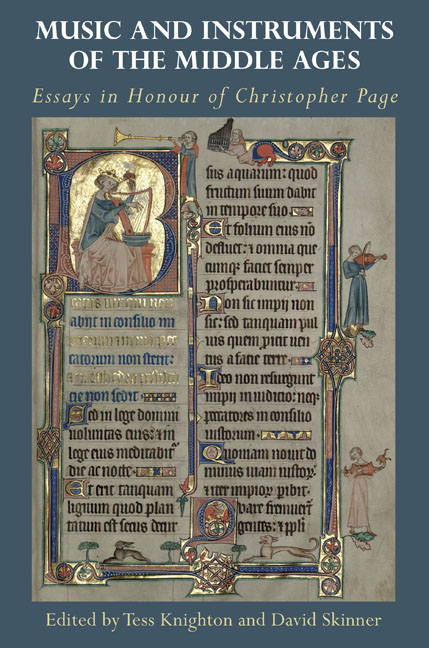Book contents
- Frontmatter
- Contents
- List of Illustrations
- List of Music Examples
- List of Tables
- List of Contributors
- List of Music Manuscript Sigla
- Acknowledgements
- Introduction
- SONGSTERS AND THEIR REPERTORIES
- CLOSE READINGS
- CREATING POLYPHONY
- MUSIC AS CULTURAL PRACTICE
- Works Cited
- Works by Christopher Page
- Index
- Tabula Gratulatoria
- Studies in Medieval and Renaissance Music
14 - Instrumentalists and Changing Performance Contexts, c. 1500
Published online by Cambridge University Press: 24 November 2020
- Frontmatter
- Contents
- List of Illustrations
- List of Music Examples
- List of Tables
- List of Contributors
- List of Music Manuscript Sigla
- Acknowledgements
- Introduction
- SONGSTERS AND THEIR REPERTORIES
- CLOSE READINGS
- CREATING POLYPHONY
- MUSIC AS CULTURAL PRACTICE
- Works Cited
- Works by Christopher Page
- Index
- Tabula Gratulatoria
- Studies in Medieval and Renaissance Music
Summary
For performers the last two or three decades of the fifteenth century were a period of deeply disruptive change. This created challenges particularly for instrumentalists, as for them striking a balance between conflicting tensions was problematic, but crucial for professional success. On the one hand was the desire to conform to traditions, on the other the constant pressure to accommodate to new concepts. The disposition to adhere to tradition was deep seated. These performers worked within a highly developed unwritten practice. For a young apprentice instrumentalist, repertories and performance techniques were imprinted through a pedagogy that stressed rote repetition. To learn counterpoint or melodic embellishment, patterns were heard, played back, and repeated again and again until thoroughly absorbed. Material learned in this fashion was not easily discarded. At the same time, concepts at all levels were constantly evolving. New musical instruments arrived to change the landscape of the profession, and new concepts of musical construction were evolving, most critically the shift from a tenor-based structure (basically three-part) to (in about 1490) a compositional approach based on imitative counterpoint – which incorporated four and more parts. Moreover, no element of change had deeper impact than that of new possibilities for combinations of singers with players, further complicated by completely new performance contexts. This last set of changes – of ensemble combinations and of performance context – will provide the focus of this study. We shall consider those changes as they evolved between about 1470 and 1500, and how performers responded to the new conditions that resulted.
C. 1450–70: THE ZENITH OF MEDIEVAL TRADITIONS
A clear understanding of the attitudes toward performance practice that were in place in the mid-fifteenth century provides an essential point of departure. Modern scholarship has emphasised the medieval convention (still fully operative c. 1450) that divided instruments and their players into two basic groups based on timbres: soft and loud. The soft category included such instruments as harps, lutes, and fiddles; but it could also, as a pragmatic consideration, include solo voices. The loud group included trumpets, shawms, drums and the like. This binary division provides a useful overall perspective, but of course has a major shortcoming for the purposes of this study; that is, with its exclusive concern with instrumental music it perforce makes no accommodation for the sacred choir.
- Type
- Chapter
- Information
- Music and Instruments of the Middle AgesEssays in Honour of Christopher Page, pp. 361 - 372Publisher: Boydell & BrewerPrint publication year: 2020

